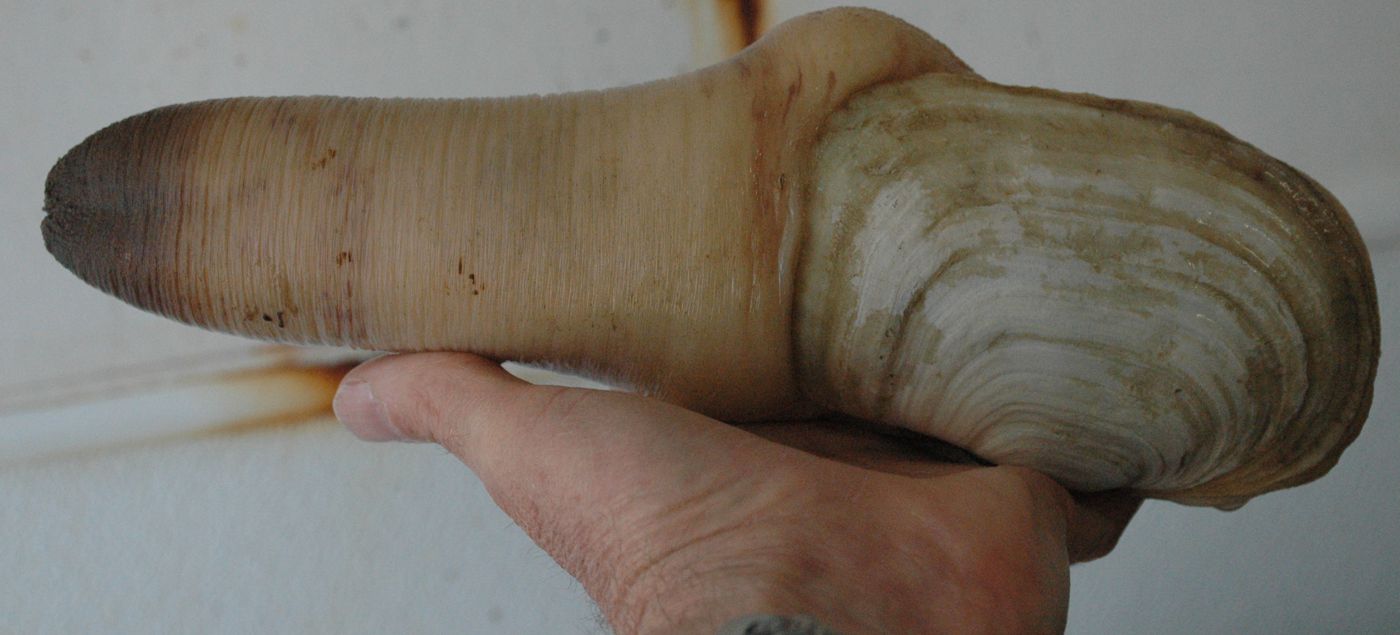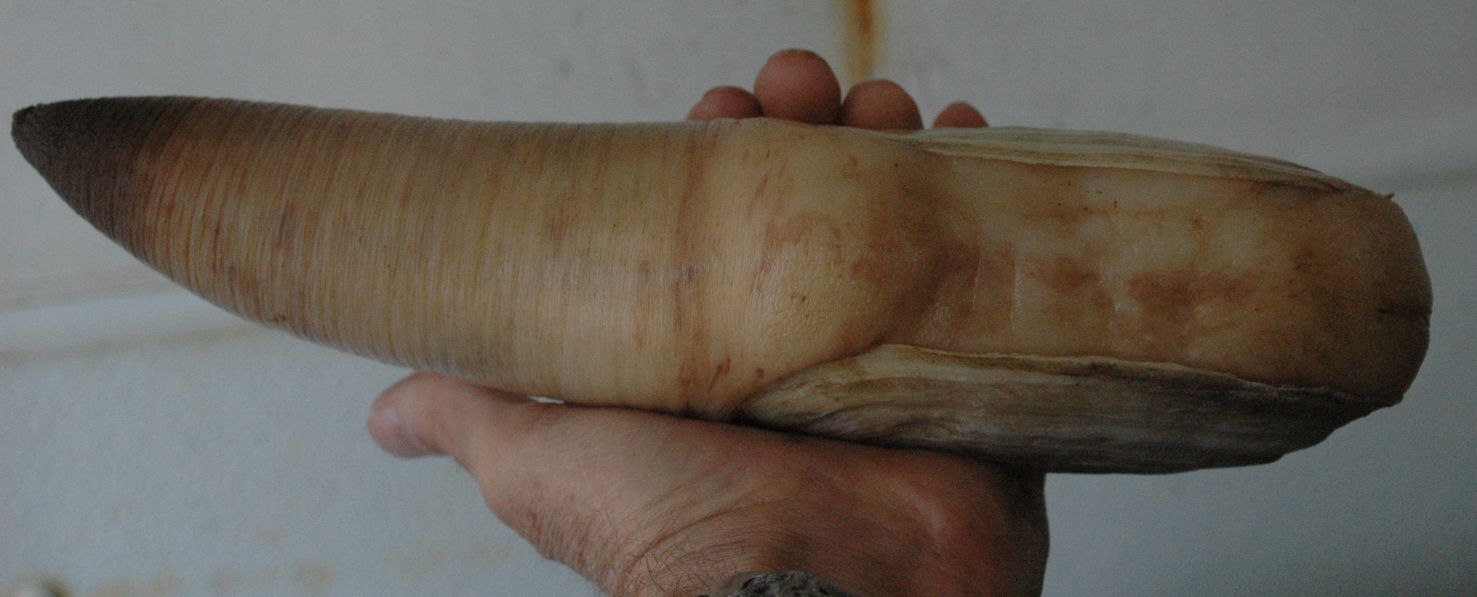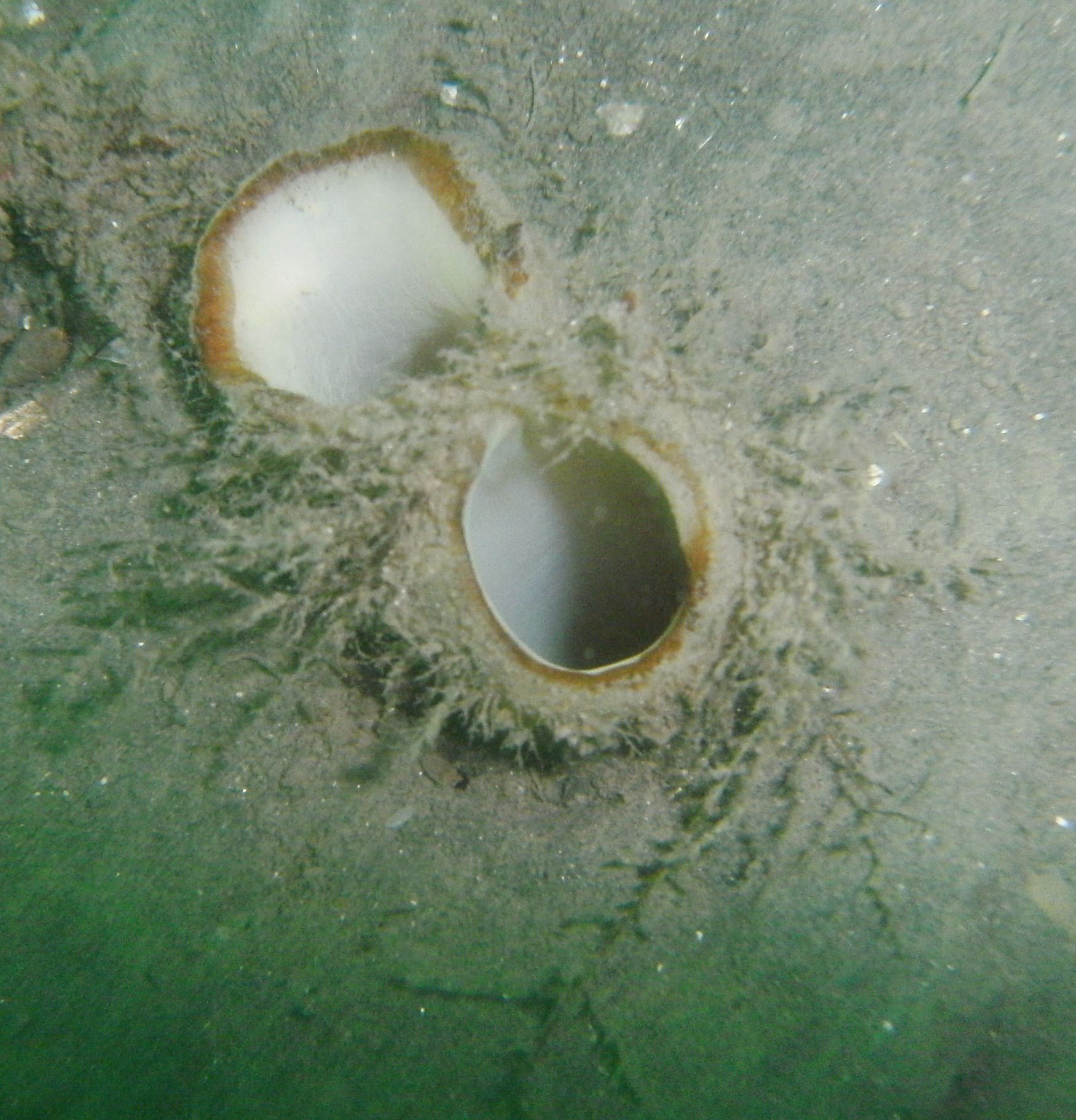Panopea abrupta (Conrad, 1849)Common name(s): Pacific geoduck clam, Geoduck clam (pronounced "goo'-ee-duck"), King clam |
|
| Synonyms: Panopa abrupta, Panope generosa, Panopea generosa | |
|
Order Myoida
Suborder Myidae
|
|
| This shell, 19 cm long, was collected in the 1800's. It was held until recently in the Washington State University museum. | |
| (Photo by: Dave Cowles ) | |
Description: This gigantic clam has fused siphons far too large to fit into the mantle cavity (photo). The siphons can project up to a meter from the shell and cannot be retracted into the shell. The shell is dirty white to cream with a small amount of yellow periostracum (photo). It has well-developed concentric growth lines but no radial ribs. Each valve has one hinge tooth. The shell gapes widely on all sides except the hinge, and very widely on the posterior (siphon) end (photo photo). Unlike most members of its family, its pallial line is continuous and wide (photo). The long siphons ares light brown with darker brown on the end (photo). There are no thick pads on the end of the siphons. Shell is quadrate (approximately rectangular in outline), more rounded on the anterior than the posterior end, up to 23 cm long, animal to 9 kg. The single hinge teeth of the two valves do not match well.
How to Distinguish from Similar Species: This is our largest local clam. Other members of family Hiatellidae are smaller and have gaping valves but a discontinuous pallial line. Gaper clams such as Tresus capax do not get as large and gape mainly at the posterior end. The Atlantic geoduck, P. bitruncata, does not live here and is smaller.
Geographical Range: Coast of Asia down to Japan; in North America from central Alaska to Newport Bay, CA; Mexico; Panama. In the Salish Sea area they are especially common in Hood Canal and Puget Sound. More common here than farther south.
Depth Range: Subtidal down to 100 m depth
Habitat: Burrows very deeply (to 1.3 m) in soft bottoms in quiet waters.
Biology/Natural
History:
This animal
is said to be the largest burrowing clam. It does not mature
until
age 3-4. Spawning is in the spring. Young clams have spiny
shells
and often settle on the tubes of polychaetes, where they attach for a
time
by byssal threads before dropping off and digging into the
sediment.
It is very long-lived (up to at least 168 years). The
copepod Herrmanella
panopeae (Cyclopoida: Lichomologidae) has sometimes been
found as
a symbiont inside the shell. Adults of this species are poor
diggers
and do not seem to be able to dig themselves back into the mud if
removed.
Ricketts et al. state that the shell is lightweight but the shell of
the
specimen above is probably 1/2 cm thick.
| Return to: | |||
| Main Page | Alphabetic Index | Systematic Index | Glossary |
References:
Dichotomous Keys:Carlton, 2007
Flora and Fairbanks, 1965 (as P. generosa)
Kozloff, 1987, 1996 (as Panope abrupta)
General References:
Abbott,
1986
Harbo, 1997,
2011
Johnson
and Snook, 1955
Kozloff,
1993 (as P.
generosa)
Lamb
and Hanby, 2005
Morris,
1966 (as P.
generosa)
Niesen 1994,
1997
(as P. generosa)
O'Clair
and O'Clair, 1998
Rice,
1971
Ricketts
et al., 1985
Sept,
1999
White,
1976
Scientific Articles:
Web sites:
General Notes and
Observations: Locations,
abundances, unusual behaviors:
I have never found this clam in the region right near Rosario Beach Marine Lab, except on commercial farms such as Taylor Shellfish Farm. It is much more common in the southern reaches of the Salish Sea such as Puget Sound and Hood Canal. It is also found in British Columbia.
The shell gapes widely, especially on the posterior (siphon) end (to the right)
The shell has a very well-developed pallial
line and one hinge tooth in each valve. The shell
of this specimen
is about 1/2 cm thick. Along the edges the shell splits into
an inner
and an outer shelf which diverge from each other slightly. I
have
not seen this divergence into shelves described for this species.

This view of a living individual from the right side illustrates the
fact that the siphon is so large that it cannot be retracted into the
shell and the shell therefore gapes widely. Photo by Dave Cowles,
August 2016 of a farmed clam at Taylor Shellfish Farms near Rosario.

The same individual from the ventral side

The same individual from the dorsal side.

These
are the siphons of a geoduck clam feeding at 50 foot depth in Burrows
Bay. The siphons can be very large (up to 5-7 cm in diameter each).
They are smooth and white inside, united all the way to the top, and
have a smooth opening with no screening tentacles, but the outside is
brown and rough. Photo by Dave Cowles, August 2019
Authors and Editors of Page:
Dave Cowles (2010): Created original page
CSS coding for page developed by Jonathan Cowles (2007)
Rosario Invertebrates web site provided courtesy of Walla Walla University